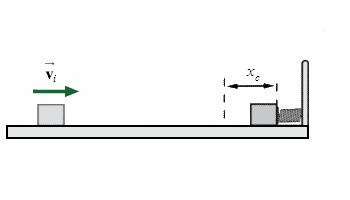cbarker1
Gold Member
MHB
- 345
- 23
Dear Every one,
Here is the question to the problem:
As shown in the figure below, a box of mass m = 5.00 kg is sliding across a horizontal frictionless surface with an initial speed vi = 2.40 m/s when it encounters a spring of constant k = 2230 N/m. The box comes momentarily to rest after compressing the spring some amount xc. Determine the final compression xc of the spring.

Is there way to use the Work-Energy Thereom to solve this problem? If so, you help me through step by step directions?
Thanks,
Cbarker1
Here is the question to the problem:
As shown in the figure below, a box of mass m = 5.00 kg is sliding across a horizontal frictionless surface with an initial speed vi = 2.40 m/s when it encounters a spring of constant k = 2230 N/m. The box comes momentarily to rest after compressing the spring some amount xc. Determine the final compression xc of the spring.

Is there way to use the Work-Energy Thereom to solve this problem? If so, you help me through step by step directions?
Thanks,
Cbarker1